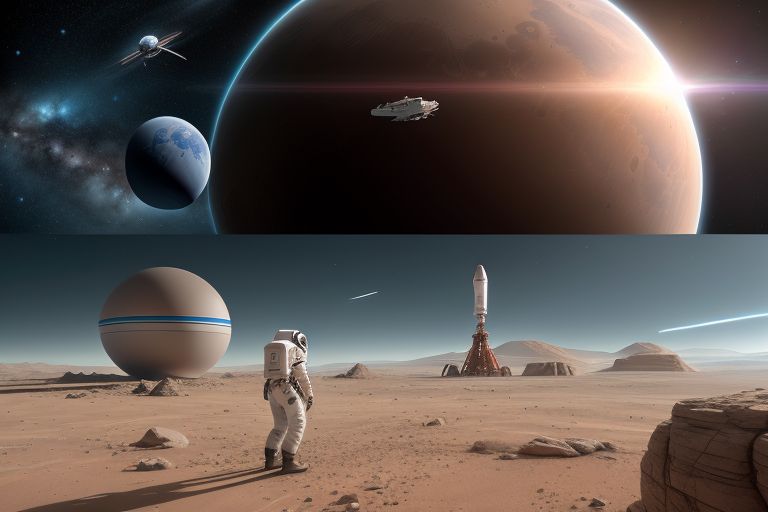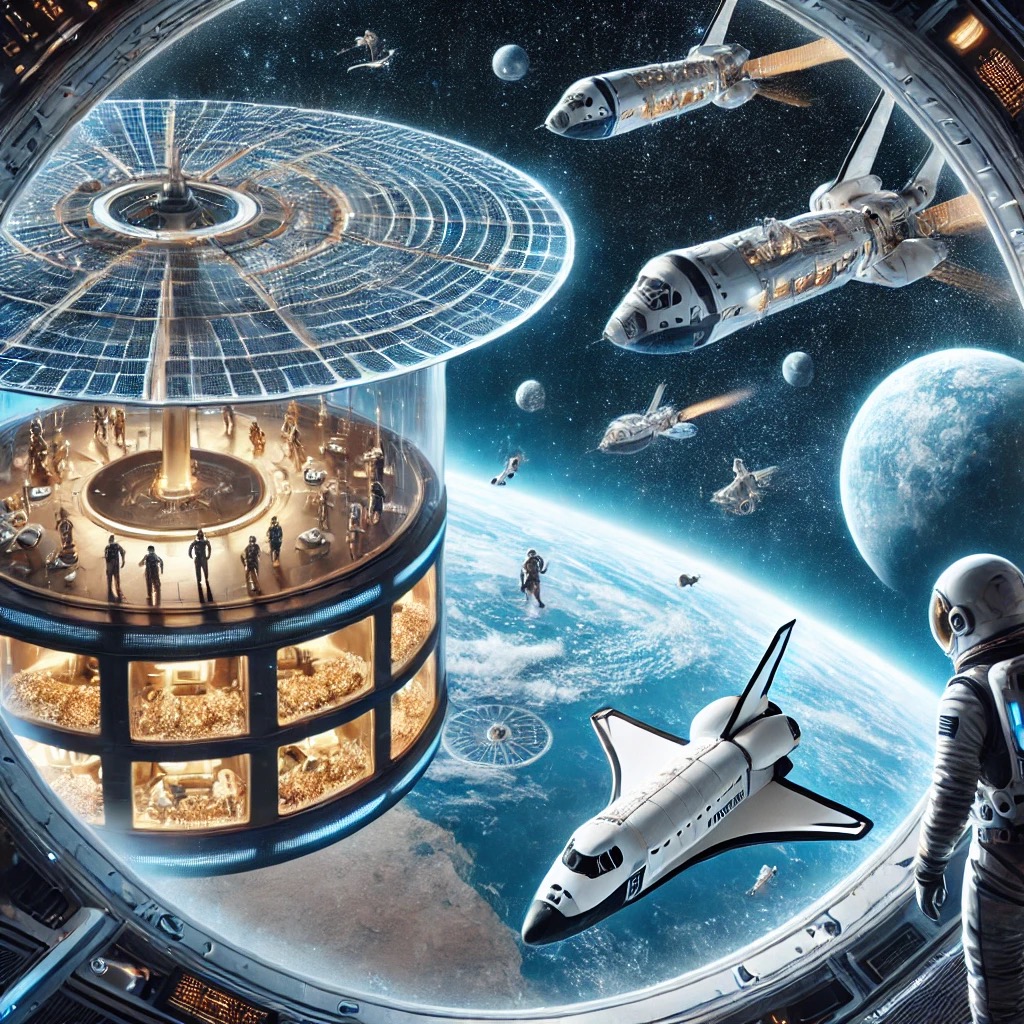Space exploration has always been a testament to humanity’s curiosity, ambition, and desire to push the boundaries of what is possible. As we stand on the cusp of a new era in space science and technology, the future promises groundbreaking achievements—from establishing colonies on Mars to embarking on interstellar travel . These endeavors are driven by advancements in propulsion systems, robotics, artificial intelligence (AI), and international collaboration, as well as private sector innovation led by companies like SpaceX , Blue Origin , and others.
Below is an exploration of the key milestones, technologies, challenges, and implications of humanity’s journey into the cosmos, from near-term missions to distant dreams of exploring other star systems.


1. The Next Frontier: Mars Colonization
a. Why Mars?
- Proximity : Mars is relatively close to Earth (6–9 months travel time) compared to other planets.
- Resources : Water ice, carbon dioxide, and minerals make it a viable candidate for sustaining human life.
- Scientific Value : Studying Mars can provide insights into planetary evolution, the potential for past or present life, and the feasibility of long-term human survival beyond Earth.
b. Current Efforts
- NASA’s Artemis Program : While focused on returning humans to the Moon, Artemis lays the groundwork for Mars missions through lunar research and testing.
- SpaceX’s Starship : Designed for interplanetary travel, Starship aims to transport humans and cargo to Mars, with plans for a self-sustaining colony within decades.
- International Collaboration : Agencies like ESA, CNSA (China), and ISRO (India) are conducting robotic missions to study Martian geology, climate, and habitability.
c. Challenges of Mars Colonization
- Radiation Exposure : High levels of cosmic radiation pose health risks during transit and on the surface.
- Life Support Systems : Developing sustainable methods for producing food, water, and oxygen is critical.
- Psychological Impact : Long isolation periods require robust mental health support and social structures.
d. Vision for a Martian Colony
- Self-Sufficiency : Utilizing in-situ resource utilization (ISRU) to extract materials for fuel, construction, and life support.
- Infrastructure : Building habitats, greenhouses, and energy systems powered by solar panels or nuclear reactors.
- Economic Models : Establishing mining operations, tourism, and scientific research as economic drivers.

2. Beyond Mars: Exploring the Outer Solar System
a. Jupiter’s Moons
- Europa : Beneath its icy crust lies a subsurface ocean that may harbor extraterrestrial life. Missions like NASA’s Europa Clipper aim to explore this possibility.
- Ganymede and Callisto : Potential sites for future outposts due to their abundant water and shielding from radiation.
b. Saturn’s Titan
- Rich in organic compounds and liquid methane lakes, Titan offers unique opportunities for astrobiology and resource extraction.
c. Asteroid Mining
- Near-Earth asteroids contain valuable resources like platinum, rare earth metals, and water, which could fuel deep-space missions and reduce costs.
3. Interstellar Travel: Reaching Other Star Systems
a. The Challenge of Distance
- Light-Years Away : The nearest star system, Proxima Centauri, is over 4 light-years away—a journey that would take thousands of years with current technology.
- Breakthrough Propulsion : Achieving significant fractions of the speed of light requires revolutionary concepts such as fusion engines, antimatter propulsion, or warp drives.
b. Breakthrough Initiatives
- Breakthrough Starshot : A project aiming to send tiny, laser-propelled spacecraft to Alpha Centauri at 15-20% the speed of light.
- Project Orion : Hypothetical designs using nuclear pulse propulsion for interstellar voyages.
- Generation Ships : Massive vessels designed to sustain multiple generations during centuries-long journeys.
c. AI and Robotics
- Autonomous probes equipped with AI will likely precede human travelers, mapping destinations and preparing habitats.
- Robotic explorers could mine resources or construct infrastructure before humans arrive.
4. Technologies Enabling the Future of Space Exploration
a. Advanced Propulsion Systems
- Nuclear Thermal Propulsion (NTP) : Offers higher efficiency than chemical rockets, reducing travel times to Mars and beyond.
- Ion and Plasma Engines : Provide continuous thrust over long durations, ideal for deep-space missions.
- Solar Sails : Harness photon pressure from sunlight for propulsion, suitable for lightweight probes.
b. Life Support and Sustainability
- Closed-Loop Systems : Recycle air, water, and waste to create self-sustaining environments.
- Synthetic Biology : Engineer microorganisms to produce food, medicine, and building materials.
c. Artificial Intelligence
- AI optimizes mission planning, navigation, and autonomous decision-making in remote environments.
- Machine learning analyzes vast datasets from telescopes and rovers to identify targets of interest.
d. Space Habitats
- O’Neill Cylinders : Massive rotating structures providing artificial gravity and large living spaces.
- Lunar and Martian Bases : Serve as stepping stones for deeper space exploration.
5. Benefits of Space Exploration
a. Scientific Discovery
- Understanding the origins of the universe, the potential for life beyond Earth, and the dynamics of celestial bodies expands human knowledge.
b. Technological Innovation
- Spin-off technologies improve healthcare, telecommunications, materials science, and environmental monitoring.
c. Global Unity
- Collaborative efforts like the International Space Station (ISS) foster peace and cooperation among nations.
d. Planetary Defense
- Monitoring and deflecting asteroids protects Earth from catastrophic impacts.
e. Inspiration
- Space exploration inspires future generations to pursue careers in STEM fields and dream big.
6. Challenges and Risks
a. Cost
- Funding ambitious projects requires significant investment, often competing with pressing issues like poverty and climate change.
b. Ethical Considerations
- Contaminating alien ecosystems with Earth microbes raises concerns about planetary protection.
- Exploiting extraterrestrial resources must be done responsibly and equitably.
c. Human Factors
- Prolonged exposure to microgravity affects bone density, muscle mass, and cardiovascular health.
- Psychological resilience is crucial for coping with isolation and confinement.
d. Political Barriers
- National rivalries and lack of regulatory frameworks could hinder international cooperation.
7. Broader Implications for Humanity
a. Survival of the Species
- Establishing colonies on other planets ensures humanity’s survival in case of global catastrophes on Earth.
b. Cultural Evolution
- Living in space will reshape societal norms, governance models, and even human biology over time.
c. Philosophical Questions
- Encountering alien life forces us to reconsider our place in the universe and redefine what it means to be “human.”
8. The Future Vision of Space Exploration
Looking ahead, the future of space exploration envisions:
a. Multiplanetary Civilization
- Humans thriving on multiple worlds, connected by advanced transportation networks.
b. Galactic Expansion
- Step-by-step exploration of nearby star systems, laying the foundation for humanity’s expansion across the galaxy.
c. Fusion of Human and Machine
- Enhanced cognition and physical capabilities through cybernetics and genetic engineering enable adaptation to harsh environments.
d. Sustainable Practices
- Space activities prioritize ecological balance, ensuring that humanity becomes a responsible steward of the cosmos.
9. Conclusion
The future of space exploration represents not just a leap into the unknown but a profound transformation of humanity’s relationship with the universe. By pursuing Mars colonies, venturing into the outer solar system, and ultimately reaching for the stars, we expand our horizons, challenge our limits, and secure a brighter future for generations to come.
However, realizing these visions requires overcoming immense technical, ethical, and financial hurdles. It demands global cooperation, innovative thinking, and unwavering determination. As we embark on this grand adventure, one thing is certain: the quest to explore space is not just about discovering new worlds—it’s about rediscovering ourselves and our shared destiny as explorers of the cosmos.
The journey begins now, and the possibilities are infinite.



